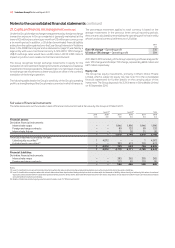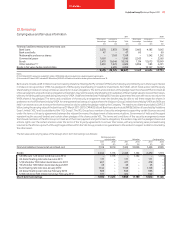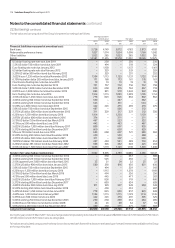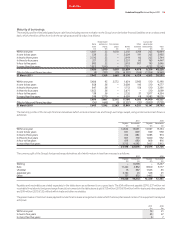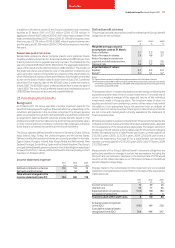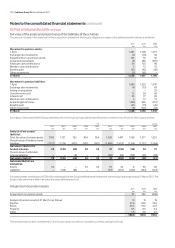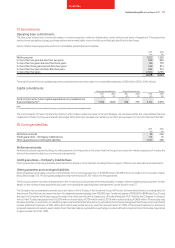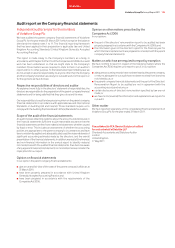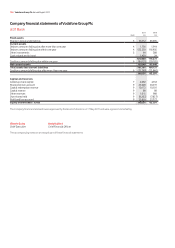Vodafone 2011 Annual Report Download - page 124
Download and view the complete annual report
Please find page 124 of the 2011 Vodafone annual report below. You can navigate through the pages in the report by either clicking on the pages listed below, or by using the keyword search tool below to find specific information within the annual report.122 Vodafone Group Plc Annual Report 2011
28. Contingent liabilities continued
Legal proceedings
The Company and its subsidiaries are currently, and may be from time to
time, involved in a number of legal proceedings, including inquiries from, or
discussions with, governmental authorities that are incidental to their
operations. However, save as disclosed below, the Company and its
subsidiaries are not currently involved in any legal or arbitration proceedings
(including any governmental proceedings which are pending or known to
be contemplated) which may have, or have had in the 12 months preceding
the date of this report, a significant effect on the financial position or
profitability of the Company and its subsidiaries. With the exception of the
Vodafone 2 enquiry, due to inherent uncertainties, no accurate
quantification of any cost, or timing of such cost, which may arise from any
of the legal proceedings outlined below can be made.
The Company was one of a number of co-defendants in four actions filed in
2001 and 2002 in the Superior Court of the District of Columbia in the
United States alleging personal injury, including brain cancer, from mobile
phone use. The Company is not aware that the health risks alleged in such
personal injury claims have been substantiated and vigorously defends such
claims. In August 2007 the trial court dismissed all four actions against the
Company on the basis of the federal pre-emption doctrine. On 29 October
2009 the District of Columbia Court of Appeals ruled on the plaintiffs’ appeal
of the trial court’s dismissal of all claims in the action on the basis of the
federal pre-emption doctrine. The Court of Appeals has upheld the dismissal
of most claims. However, the decision permits the plaintiffs to continue any
claims alleging i) injuries in respect of mobile phones purchased before 1
August 1996 (the date of the Federal Communication Commission’s Specific
Absorption Rate standard (‘FCC standard’)); ii) injuries in respect of mobile
phones alleged not to have complied with the FCC standard; and iii) fraud
and misrepresentation in respect of the sale or marketing of mobile phones
in question. The cases were returned to the trial court to be adjudicated in
accordance with the Court of Appeals’ decision and on 3 May 2010 plaintiffs
in the four actions filed amended complaints with the Superior Court.
The defendants filed a motion to dismiss the amended complaints on
30 July 2010. The plaintiffs in these four actions have agreed to dismiss
the Company from the actions on jurisdiction grounds. However, the
plaintiffs have reserved the right to re-commence the actions against the
Company if evidence supporting an assertion of jurisdiction were to emerge.
On 30 September 2010 the plaintiffs filed a stipulation for the voluntary
dismissal of the Company and the order granting the stipulation dismissing
the Company without prejudice was entered on the court record on
5 October 2010.
On 22 July 2010 the Company settled the Vodafone 2 CFC case with HMRC
by agreeing to pay £1.25 billion (comprising £800 million in the 2011
financial year, with the balance to be paid in instalments over the following
five years) in respect of all outstanding CFC issues from 2001 to date. It was
also agreed that no further UK CFC tax liabilities will arise in the near future
under current legislation. Longer term, no CFC liabilities are expected to
arise as a consequence of the likely reforms of the CFC regime due to the
facts established in this agreement.
Vodafone Essar Limited (‘VEL’) and Vodafone International Holdings B.V.
(‘VIHBV’) each received notices in August 2007 and September 2007
respectively, from the Indian tax authority alleging potential liability in
connection with alleged failure by VIHBV to deduct withholding tax from
consideration paid to the Hutchison Telecommunications International
Limited group (‘HTIL’) in respect of HTIL’s gain on its disposal to VIHBV of its
interests in a wholly-owned subsidiary that indirectly holds interests in VEL.
Following the receipt of such notices, VEL and VIHBV each filed writs
seeking orders that their respective notices be quashed and that the tax
authority take no further steps under the notices. Initial hearings were held
before the Bombay High Court and in the case of VIHBV the High Court
admitted the writ for final hearing in June 2008. In December 2008 the
High Court dismissed VIHBV’s writ. VIHBV subsequently filed a special leave
petition to the Supreme Court to appeal the High Court’s dismissal of the
writ. On 23 January 2009 the Supreme Court referred the question of the
tax authority’s jurisdiction to seek to pursue tax back to the tax authority for
Notes to the consolidated nancial statements continued
adjudication on the facts with permission granted to VIHBV to appeal that
decision back to the High Court should VIHBV disagree with the tax
authority’s findings. On 30 October 2009 VIHBV received a notice from the
tax authority requiring VIHBV to show cause as to why it believed that the
tax authority did not have competent jurisdiction to proceed against VIHBV
for the default of non-deduction of withholding tax from consideration paid
to HTIL. VIHBV provided a response on 29 January 2010. On 31 May 2010
VIHBV received an order from the Indian tax authority confirming their view
that they did have jurisdiction to proceed against VIHBV as well as a further
notice alleging that VIHBV should be treated as the agent of HTIL for the
purpose of recovering tax on the transaction. VIHBV appealed this ruling to
the Bombay High Court. On 8 September 2010 the Bombay High Court
ruled that the tax authority had jurisdiction to decide whether the
transaction or some part of the transaction could be taxable in India. VIHBV
appealed this decision to the Supreme Court on 14 September 2010. A
hearing before the Supreme Court took place on 27 September 2010 at
which the Supreme Court noted the appeal and asked the tax authority to
quantify any liability. On 22 October 2010 the Indian tax authority
quantified the alleged tax liability and issued a demand for payment of INR
112.2 billion (£1.6 billion) of tax and interest. VIHBV has contested the
amount of such demand both on the basis of the calculation and on the
basis that no tax was due in any event. On 15 November 2010 VIHBV was
asked to make a deposit with the Supreme Court of INR 25 billion (£356
million) and provide a guarantee for INR 85 billion (£1,188 million) pending
final adjudication of the case, which request it duly complied with. The
Supreme Court will now hear the appeal on the issue of jurisdiction as well
as on the challenge to quantification on 19 July 2011. On 23 March 2011
VIHBV received a notice requesting it to explain why it should not be liable
for penalties of up to 100% of any tax found due for alleged failure to
withhold. On 15 April 2011 the Supreme Court, in response to an application
made by VIHBV, allowed the Indian tax authority to continue its
investigations into the application of penalties but stayed the Indian tax
authorities from enforcing any liability until after the outcome of the
Supreme Court hearing scheduled for 19 July 2011. After investigations, on
29 April 2011, the Indian tax authority raised an order alleging penalties
were due but noting that these will not be enforced in line with the Supreme
Court stay. In addition, the separate proceedings taken against VIHBV to
seek to treat it as an agent of HTIL in respect of its alleged tax on the same
transaction have been deferred until the outcome in the first matter is
known. VEL’s case also continues to be stayed pending the outcome of the
VIHBV Supreme Court hearing. VIHBV believes that neither it nor any other
member of the Group is liable for such withholding tax, or is liable to be
made an agent of HTIL; however, the outcome of the proceedings remains
uncertain and such proceedings may or may not dispose of the matter in
its entirety and there can be no assurance that any outcome will be
favourable to VIHBV or the Group.
In light of the uncertainty created by the Indian tax authority’s actions as set
out above, VIHBV, through its indirect wholly owned subsidiary Euro Pacific
Securities Ltd, has sought confirmation from the Authority for Advanced
Rulings (‘AAR’) in India on whether tax should be withheld in respect of
consideration payable on the acquisition of Essar Group’s (‘Essar’) offshore
holding in VEL. A ruling from the AAR is expected by the end of May 2011 at
the latest. The Group does not believe that there is any legal requirement to
withhold tax in respect of these transactions but if, contrary to expectations,
the AAR directs tax to be withheld, this amount is anticipated to be
approximately an additional US$1 billion.


